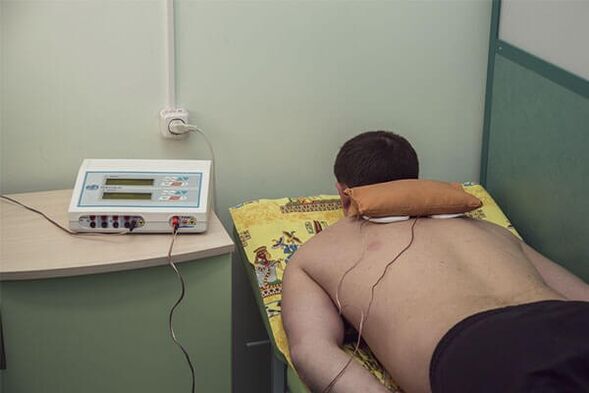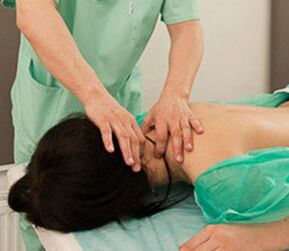Osteochondrosis is degenerative-district disorders in the cartilage tissue of the intervertebral joints, causing their deformation and destruction.Osteochondrosis can develop in one or more spine.Osteochondrosis of the cervical regionIt happens especially often, and sometimes gives very serious complications.

Characteristics of cervical back osteochondrosis
Due to the features of the cervical spine structure, the course and the symptoms of osteochondrosis in this segment have a number of features.The cervical spine consists of small movable beads, which are constantly undergoing significant and long loads.The vertebral canal in the cervical region is narrower, so compression of the spinal cord in this segment develops much more often and leads to very serious lesions.In the neck there is a large accumulation of nerve endings and blood vessels, including vertebral arteries, which provides brain food, prolonged brain and back of the brain.Violation of blood flow to this artery leads to a violation of coordination, dizziness, vision and hearing reduction, and in severe cases a stroke may develop.
Symptoms of osteochondrosis of the cervical back
Osteochondrosis of the cervical regionThe back is manifested by several syndromes:
-
Reflex and irritating syndrome
Burning pain in the conscious cervical region, which arises after sneezing, sudden head movements or a long static condition, for example, after sleep or a fixed state and subsequent head or neck movement complain with osteochondrosis of the cervical.The pain can radiate to the shoulder or chest cage. Spinal canal narrowing syndrome (spinal canal stenosis)
This syndrome develops as a result of compression (squeezing) of the spinal cord and its vessels, which leads to circulatory disorders in the affected area and the development of myelopathy - a rare but more frightening complication of osteochondrosis.Vertro -carbon cervical myelopathy occurs mainly in middle and elderly persons as a result of compression of the spinal cord or its vessels with posterior osteophytes, thick yellow ligament, intervertebral disc herniation.The disease develops gradually, at first, the pain and restriction of movements in the cervical spine are often observed.In the future, cervical osteochondrosis can cause damaged functions of upper and/or lower extremities, manifested by numbness, a feeling of sensitive sensitivity to the fingers, a feeling of the feet or wings of the cotton, until the development of paresis and paralysis-
Novice syndrome
Manifestations of radical syndrome in osteochondrosis of the cervical spine will depend on that compression of which the nerve root arises as a result of structural changes in the disc.However, in any case, cervical osteochondrosis will occur with headaches that have a painful, pulsating or burning character, sometimes leaking into the type of hypertension.Back pain is rarely local and usually gives shoulder, forearm, shoulder and/or hand blades, up to the fingers of the brush.
Depending on the affected spine segment, the following symptoms may be:
- C1-C2: Loss in this segment, as a rule, occurs as a result of automotive damage and manifests itself by a violation of the wind and speech, facial and sublingual muscle hypotrophy and a decrease in occipital region.
- C2-C3: It is also rarely affected and associated with impaired hearing, vision and control of the movement and sensitivity of the muscle of the tongue, which leads to speech disorders and taste sensations, the appearance of a sense of inflammation, sweating or a lump in the throat.
- C3-C4: Since the diaphragmatic nerve retires in this segment, in addition to the pain in the clavicle and the shoulder GPU, the strap spam and trapezoidal muscles, the pain in the hypochondrium and the right heart also develop, and the respiratory movements are disturbed.Moreover, folly, a feeling of nasal congestion, snoring, landing, shaky facial muscles, deterioration of the toothpaste can develop.
- C4-C5: Loss in this segment is associated with painful shoulder shoulder sensations, deltoid muscle hypotrophy, a decrease in the sensitivity of the outer surface of the shoulder, shoulder shoulder and inflammation of the skeletal muscles in the area.Among other symptoms, changes in sound, feeling inflammation in the larynx, snoring can occur.
- C5-C6: The segment is most often susceptible to degenerative-textrophic lesions and has extensive symptoms.First of all, the pain and sensitivity of the skin damaged by the shoulder blade develops the outer surface of the shoulder on the radial surface of the forearm and the thumb develops.Subsequently, somatic symptoms develop, including frequent and poorly undergoing lung and bronchitis treatment, including asthma, rheumatic and allergic manifestations, pectoris angina symptoms.
- C6-C7: The nerve roof lesion in this segment leads to the appearance of pain in the scapula, the back surface of the shoulder, along the pre-surface of the forearm in the back of the hand.Moreover, damage to this segment may accompany symptoms that correspond to thyroid diseases, mediastinal organs and cardiovascular system.
- C7-T1: Spine lesion C8 is associated with muscle hypertrophy with three heads and little deviation finger, which leads to a weakening of the reflex and pain with damaged skin sensitivity from the neck, shoulder, shoulder, elbow joint and little finger.In severe cases, symptoms can develop such as angina pectoris, arrhythmia and asthma.
-
Cardial syndrome for cervical osteochondrosis
Cardial syndrome develops with irritation of the nerve roots innovated by the diaphragm (diaphragmatic nerve) or a large chest muscle.Symptoms are undoubtedly identical to the attack of angina pectoris, but at the same time the attack lasts long, the pain intensifies with a sharp movement of the head or neck, with a sharp sneez or cough.Standard coronarylytics does not bring relief, and ECG at the time of the attack does not indicate a violation of coronary circulation.At the same time, cardiac syndrome can be associated with tachycardia, arrhythmia and high blood pressure. -
Vail artery syndrome
This syndrome is one of the most frequent and dangerous manifestationsosteochondrosis of the cervical regionThe spine this syndrome develops against the background of vertebral artery squeezing and circulatory disorders in the respective areas of the brain (cerebellum, brain stems and posterior lobes), which determines the clinical appearance.
One of the main manifestations of vertebral artery syndrome is a severe pulsating headache and/or head burning, constant or paroxysmal, exciting darkness, overestimate, whiskey and back of the head.Usually the pain can be biased.In the early stages of development, headaches arise or intensify after a long stay in an unpleasant position with his head back, after physical exercise or after sudden movements.With the narrowing of the lumen, the artery of pain becomes more pronounced and frequent, sometimes constant.In severe cases or at the height of a headache, vomiting may occur, a poor condition is not excluded.
Disordishes visual disorders with cervical osteochondrosis can occur both separately and against the backdrop of headaches and expressed by eye pain, damaged visual acuity, a feeling of veil before the eyes, dryness or stove in the eye.One of the characteristic symptoms of narrowing of the vertebral artery are sudden short -term attacks of dizziness or loss of orientation in space.Such attacks occur for a few seconds and pass quickly.An unexpected noise in the ear or pulse in the head area may occur.Also, damage to the vertebral artery can lead to the development of cardiac syndrome.
In severe cases, an attack of an "ischemic attack", manifested by severe headaches, vomiting, loss of movement coordination, a change in handwriting, walking, double, speaking and impaired balance, can develop.
Diagnosis of cervical back osteochondrosis
The doctor may make the primary diagnosis of osteochondrosis of the cervical spine already on the first examination of the patient, as well as determine the level of the affected spine, anatomical features, including behavior, physique, body structure, spicy processes, lateral neck contours;localization, nature and degree of pain syndrome;Spine amplitude, relief and muscle tone.
The diagnosis is specified using diagnostic visual methods (radiographic studies, CT, MRI), which allows you to determine the stage of the disease, the level of the spinal lesions, the exact localization of the deformed disk.And on the basis of this data, the most optimal treatment of cervical osteochondrosis is chosen.
Treatment of cervical back osteochondrosis

In the treatment of cervical osteochondrosis, surgical and conservative methods are used.But surgical treatment is prescribed only in the presence of severe complications that occur in later stages of osteochondrosis if:
- Stenosis (narrowing) of the spinal canal was formed;
- Vertebral artery is suppressed;
- A significant hernia or extension was formed, compressing the nerve roots;
- Excessive spine instability developed.
In other cases the standard of treatmentosteochondrosis of the cervical regionThe back is conservative therapy.This is due to the fact that with all the achievements of modern medicine, the consequences of surgical intervention are not always expected.
Conservative treatment of cervical osteochondrosis
The best results in treatmentosteochondrosis of the cervical regionThe back, as well as other types of osteochondrosis, are achieved when you see a doctor.Unfortunately, many patients often do not pay attention to the little discomfort in the back or periodic headaches.On the other hand, there are many cases of improper diagnosis and long useless treatment, sinceOsteochondrosis of the cervical regionThe spine can simulate other diseases, such as arthritis, myalgia or angina pectoris.This is why vertebologists recommend checking the spine in the presence of symptoms of any disease, especially accompanied by head or spinal pain.
In the effective treatment of cervical osteochondrosis, an integrated approach is of great importance, including the following instructions:
- Drug therapy- Aiming in improving intervertebral disc trophism and stopping pain, removing muscle spasm and inflammation during irritation.For these purposes, non -steroidal anti -inflammatory drugs, analgesics, muscle relaxants, chondroprotectors are prescribed in order to stimulate the restoration of the cartilage tissue, multivitamins and vitamins of group B;
- physiotherapy- is prescribed to reduce pain, improve disk tissue nutrition, stimulation of cartilage regeneration processes, removing muscle spasm, inflammatory processes in the post -surgery period for rapid recovery;
- Manual therapy- It is used to eliminate muscle cramps, reduce pain, improve blood metabolism and lymph, behavioral correction and improve amplitude of the joints.Manual exposure scheme is selected individually for each patient;
- massage-Determine the method used for a long time and determined to treat diseases of the muscular system.Has the same effect as manual therapy;
- Physical educationIt is one of the most important methods for the treatment of all types of osteochondrosis, including osteochondrosis of the cervical spine.The purpose of exercise therapy is to relieve muscle spasm and compression of the nerve roots, improve blood flow and lymph in the back, strengthen the muscle frame and increase the flexibility of the ligaments.For each patient, a set of exercises is chosen, the exact implementation of which is monitored by a specialist;
- reflexologyIt refers to an alternative type of treatment, widely used today and gives a very good result in combination with other methods of treatment.The essence of the method is the impact on acupuncture points and/or reflexogenic areas in order to achieve the same results as with other therapeutic methods (decreased muscle pain and spasm, decompression of the spinal roots, improve tissue trophies in vertebrae), as well as to improve sleep, so-sleep, so-sleep.

For the treatment of chronic osteochondrosis, chondroprotectors, group B vitamins (B6, B12), and medicines for external use are also used - ointments, creams, gels containing NSAIDs, local stimulants of regeneration and tissue regeneration.
In addition to the main methods of treatment, with osteochondrosis of the cervical region, patients are recommended to change the usual lifestyle, as in most cases the disease continues against the background of low mobility, weak or malnutrition, overweight or, in contrast, with extremely low weight and the presence of bad habits.In most cases, in the early stages of cervical osteochondrosis, it is enough to lead a healthy lifestyle, to prevent muscle spasms and overload of the cervical ignition region, provide comfortable sleeping conditions, normalize the doctor and fulfill your doctor's recommendations.Further to the pathological process, and even achieve healing in the first phase.



















